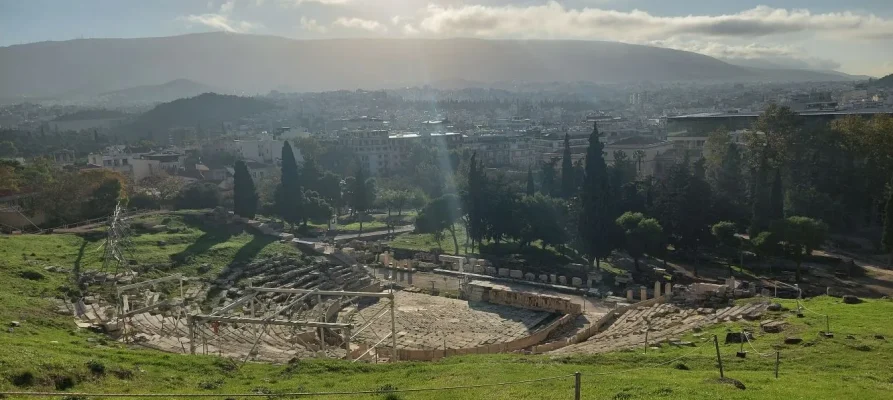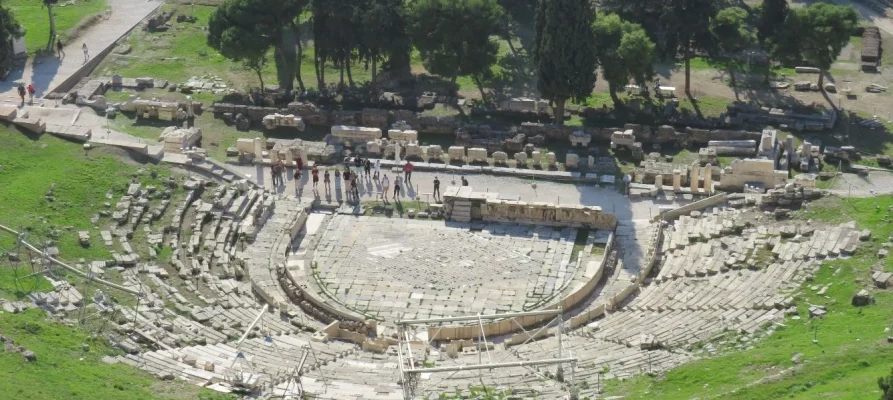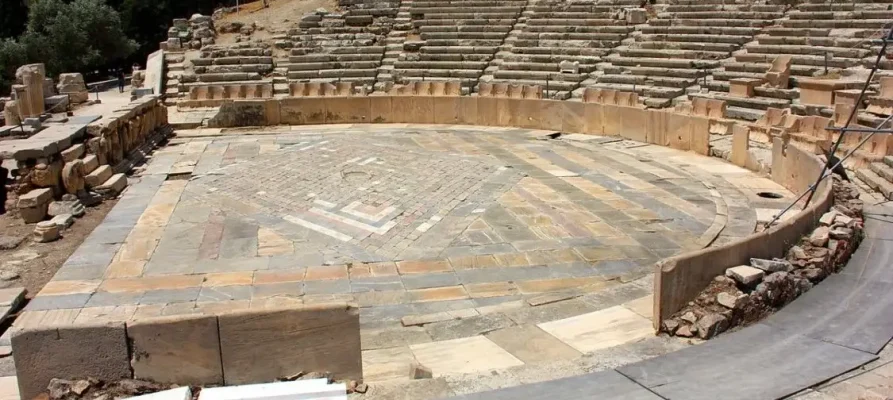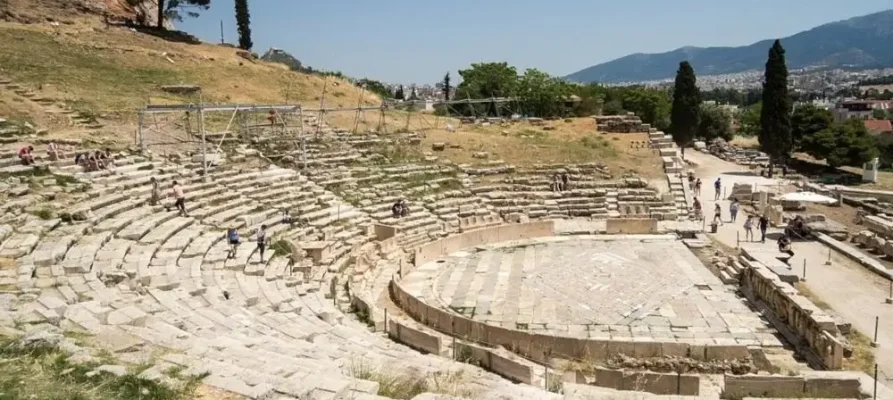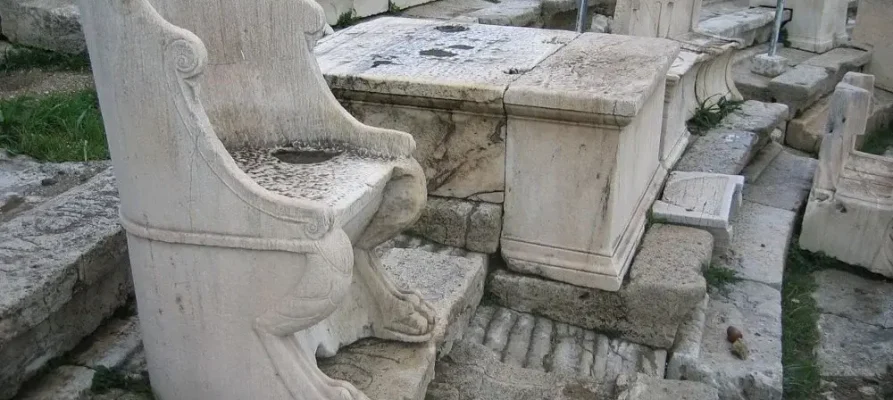
Theatre of Dionysus
I can’t begin to express how thrilled I am to share one of Athens’s most awe-inspiring ancient sites: the Theatre of Dionysus. Its rich history, breathtaking architecture, and unique cultural significance make it an absolute must-visit for anyone travelling to this beautiful city.
Located on the southern slope of the world-renowned Acropolis of Athens, the Theatre of Dionysus is an absolute gem steeped in ancient history. As you wander through the ruins, you’ll almost be able to hear the echoes of the past, with the spirits of long-gone actors and playwrights lingering in the air. This theatre, my friends, is where it all began; it’s the birthplace of Western theatre and drama as we know it today.
As its name suggests, the Theatre of Dionysus was built to honour the god of wine, fertility, and, of course, theatre: Dionysus. The ancient Athenians believed that the art of drama was a gift from this god, and so they constructed this monumental theatre to pay homage to him. It’s also known as the Dionysia, which refers to the festivals held in his honour, where playwrights would stage their plays and compete for the top prize.
Now, let’s dive into what makes this theatre so extraordinary. Built in the 5th century BC, it could seat up to 17,000 spectators at its peak. Imagine that! Thousands of people would gather to watch the latest tragedies and comedies penned by some of the most famous playwrights of all time, like Sophocles, Euripides, and Aristophanes. As you wander through the site, it’s hard not to be overcome with a sense of wonder at the sheer scale and ingenuity of the ancient Athenians.
The Theatre of Dionysus boasts several unique features that set it apart from other ancient theatres. The skene, or stage building, was constructed with wood in the early years but was later replaced with a stunning marble edifice. The parodoi, or entrance passages, were designed to allow for grand processions, setting the stage for the dramatic spectacles that unfolded within. The orchestra, or circular dancing area, was the focal point of the theatre, where the chorus would perform their songs and dances.
As you explore the Theatre of Dionysus, take a moment to sit on one of the remaining stone seats and imagine what it must have been like to watch a play in this magnificent setting. With the Acropolis of Athens looming above you, the sea glittering in the distance, and the scent of Mediterranean herbs wafting through the air, it’s hard not to be transported back to ancient times. It’s a truly humbling and unforgettable experience.
The Theatre of Dionysus is also an excellent starting point for exploring the Acropolis, with the Parthenon, Odeon of Herodes Atticus, Erechtheion, and other iconic landmarks just a stone’s throw away. As you ascend the hill, you’ll be rewarded with stunning panoramic views of Athens and its surrounding landscape. Trust me, it’s an experience that will leave you breathless in more ways than one.
But why should you visit the Theatre of Dionysus? It’s a rare chance to stand in the same spot where the likes of Sophocles and Euripides once stood, and to walk in the footsteps of the ancient Athenians who first gathered here to celebrate the god Dionysus. Simply put, it’s an incredible opportunity to connect with the roots of Western theatre and drama while immersing yourself in the beauty and history of ancient Athens.
As you explore the ancient ruins, take the time to soak in the atmosphere and let your imagination run wild. Picture the thousands of spectators who once filled the theatre, the actors taking to the stage in their elaborate costumes, and the playwrights anxiously awaiting the verdict of the judges. It’s a rare opportunity to step back in time and experience a piece of history that has shaped our modern world in more ways than one.
So, if you’re planning a trip to Athens, make sure the Theatre of Dionysus is at the top of your list of must-see attractions. By visiting this awe-inspiring site, you’ll not only be witnessing the birthplace of theatre and drama but also experiencing a unique, tangible connection to the ancient world. It’s a place where history and culture come alive, leaving you with memories that will last a lifetime.
These are my recommendations for the top things to see and/or do at the Theatre of Dionysus:
Ancient Stone Seating
The stone seats, or “koilon” in Greek, are an incredible sight. Just think about it – you’re standing in the very same place where ancient Athenians once gathered to watch the birth of drama unfold. As you sit on these weathered stones, imagine the atmosphere of anticipation and excitement that filled the air during performances. And don’t forget to check out the intricately carved thrones reserved for VIPs. They’re a fantastic testament to the theatre’s age and sophistication.
Stage and Orchestra
The semi-circular orchestra and stage, or “proskenion”, are the heart of the Theatre of Dionysus. It’s here where legendary playwrights like Sophocles and Euripides presented their works to the world for the first time. When you stand on this hallowed ground, take a moment to envision the actors delivering their lines and the chorus singing and dancing in the orchestra. Knowing you’re standing where the roots of theatre and performance began is a magical feeling.
Altar of Dionysus
Right at the centre of the orchestra, you’ll find the remains of the altar dedicated to Dionysus. This sacred spot holds a unique significance, as it was where sacrifices were made in honour of the god of wine, fertility, and theatre. As you explore this area, ponder the importance of the theatre in the ancient religious life and how the Dionysia festival brought the entire city together in a shared celebration of culture, art, and divinity.
Surrounding Ruins
While the theatre is the main attraction, take the chance to explore the surrounding ruins, including remnants of temples, altars, and other structures. As you wander through these atmospheric ruins, you’ll develop a deeper appreciation for the ingenuity and passion that shaped this iconic monument. Each fragment adds another layer to the rich history of the Theatre of Dionysus and helps you understand its role in the broader context of ancient Athens.
There are so many opportunities to take photos, but here are my personal top choices at the Theatre of Dionysus:
Theatre of Dionysus from above
Capture the essence of this ancient theatre by snapping a photo from above, showcasing its stunning architecture and the Acropolis in the background. This unique vantage point allows you to appreciate the site’s grandeur, making it a must-visit for history buffs and theatre enthusiasts alike.
Orchestra and skene up close
Get up close and personal with the heart of the theatre by taking a photo of the orchestra and skene. This is where the magic of the performances took place, so make sure to capture these essential elements to immerse your followers in the fascinating world of ancient Greek drama.
Acropolis view from the theatre
Don’t miss the chance to photograph the majestic Acropolis from the Theatre of Dionysus. This perspective highlights the close connection between the two sites and offers a breathtaking backdrop to your shots. Trust me, your followers will be in awe of the stunning scenery and historic atmosphere.
Stone seats and inscriptions
The ancient stone seats with inscriptions are a testament to the theatre’s long history. Snap a photo of these fascinating details to give your audience a glimpse into the lives of the spectators who once filled this iconic venue, making it an unmissable spot for anyone visiting Athens.
Sea view in the distance
As you explore the Theatre of Dionysus, don’t forget to capture the sparkling sea in the distance. This beautiful vista serves as a reminder of the theatre’s picturesque setting and adds an extra layer of charm to your photos. Your followers will be enchanted by the captivating blend of history and natural beauty.
Visiting the Theatre of Dionysus on the Acropolis of Athens is a once-in-a-lifetime experience that will leave you with unforgettable memories. To help you make the most of your trip, here are my top tips:
- Arrive early: I suggest booking in advance and online to avoid the crowds and the heat. Not only does this allow you to jump the queues, but it will also allow you to enjoy the sites in relative peace and quiet. The place I use and personally recommend is right here.
- Please wear comfortable shoes: The Erechtheion is situated on the Acropolis of Athens and is a large, rocky area with uneven terrain, so it’s essential to wear sturdy, comfortable shoes to navigate the site safely. Save the fashionable sandals for exploring the city’s charming neighbourhoods and cafes.
- Stay hydrated: Athens can be pretty hot, especially during the summer months and even during the spring. Too often, I’ve seen many people queuing for up to an hour or more in the glaring heat before they even make their way up the Acropolis. So, make sure to bring plenty of water to stay hydrated while you’re exploring the Erechtheion. Water fountains are around the site, but having your own water bottle is always a good idea.
- Bring sun protection: Remember your sunscreen, sunglasses, and a hat to protect yourself from the intense Mediterranean sun. The Acropolis offers little shade, so staying protected is essential while soaking in the history and breathtaking views.
- Take your time: The Acropolis of Athens is a treasure trove of history and architectural wonders, so don’t rush through it. Take your time to truly appreciate each site, from the grandeur of the Parthenon to the intricate details of the Erechtheion.
- Join a guided tour: A guided tour can significantly enhance your experience at the Acropolis, providing valuable insight into the history and significance of each site. Knowledgeable guides can help bring the ancient world to life, making your visit even more memorable. I personally use and recommend you book online right here.
- Explore lesser-known sites: While the Parthenon and other significant sites are undoubtedly impressive, take notice of the lesser-known gems of the Acropolis. Take the time to visit the Theatre of Dionysus, Odeon of Herodes Atticus, and Temple of Athena Nike to fully appreciate this ancient citadel’s rich history and diverse architecture.
- Visit the Acropolis Museum: To deepen your understanding of the Acropolis and its treasures, visit the Acropolis Museum. The museum houses many of the original sculptures and artefacts from the site, allowing you to gain a greater appreciation for the artistic achievements of ancient Greece. It’s just across from the entrance to the Acropolis of Athens.
- Capture the moment: The Acropolis offers a wealth of photo opportunities, from the iconic Parthenon to the sweeping views of Athens. Bring your camera or smartphone to capture these magical moments and create lasting memories.
- End your visit with a sunset: After a full day of exploration, there’s no better way to conclude your visit to the Acropolis than watching the sunset over Athens. Find a comfortable spot, perhaps near the Temple of Athena Nike or the Parthenon, and watch as the sky turns brilliant shades of orange, pink, and purple, casting a warm glow over the ancient stones.
Accessibility for those with disabilities and impairments at the Theatre of Dionysus has seen improvements in recent years. However, it’s important to keep in mind that this is an ancient archaeological site with uneven terrain and several steps. While some areas of the theatre might be challenging to navigate for visitors with mobility impairments, there are still opportunities to experience the beauty and history of this remarkable site.
A designated accessible pathway has been installed, allowing visitors using wheelchairs and mobility scooters to explore parts of the theatre. Additionally, there are ramps at certain points, making it easier to navigate between different levels of the site. However, some sections might still be inaccessible, especially those with steep inclines or stairs.
For visitors with visual impairments, the site offers tactile maps and descriptive panels to enhance the experience. These features provide a better understanding of the theatre’s layout and historical significance. It’s also a good idea to visit with a sighted companion who can help describe the surroundings in greater detail.
For those with hearing impairments, guided tours with sign language interpreters can be arranged in advance. This ensures that visitors can fully immerse themselves in the fascinating history and cultural significance of the Theatre of Dionysus.
Book Online
As the Theatre of Dionysus is part of the Acropolis of Athens, I’ve listed below the three most popular, however, a full list can be found right here.

